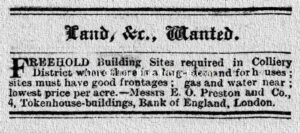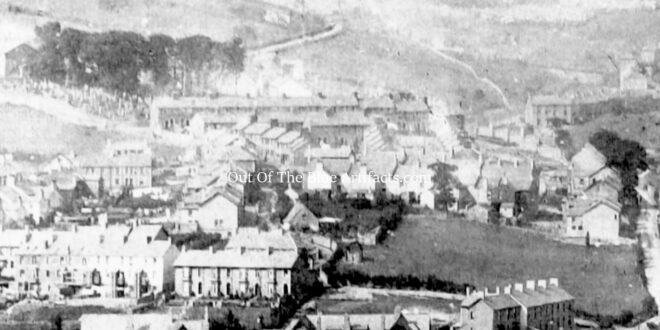 The Abertillery Land Investment Company.
The Abertillery Land Investment Company.
In 1892 Mr Edward Oxenford Preston and Co of No.4 Tokenhouse Buildings, Bank of England, London, formed the Abertillery Land Investment Company Limited, with others. The company (as seen in the advertisement left) was formed to acquire property, building sites, land and to build houses and cottages in colliery and industrial town districts.
Mr Edward Oxenford Preston Esq.
Mr Edward Oxenford Preston was a born in 1861 at Barnes, Middlesex. He later became a financier. On Wednesday 26th of September 1888, Mr Edward Oxenford Preston married Miss Isabel Maud Philpott, daughter of Mr William Philpott Esq of St Peter’s Port, Guernsey. She was also the niece to Henry Philpott the Lord Bishop of Worcester (1861-1890). Miss Isabel Maud Philpott was born in 1866 at St Peters Port, Guernsey. They had a son Edward P. O. Preston born 1891 at Cookham, Berkshire.
Messrs Gaen Bros.
Soon after the set-up of the company they hired Messrs Thomas & Charles Gaen of Abertillery as contractors and builders.
The Construction of the Houses at Brynteg.
In 1892 the company began building houses at Brynteg – Edward Street, Oxenford Street (spelled correctly as in the deeds of 1893) and Preston Street, (as seen in the main featured image above) all named after Mr Edward Oxenford Preston Esq the financier of the company (as above). Oxenford Street must have had a later name change, or the intention to name the street as Oxenford never materialised and was just shortened to Oxford Street. (I’m still searching for information).
By February 1893 eighty-four houses were built with thirteen houses having frontages on Portland Street. There were three plots yet to be built upon, a total of eighty-seven houses.
In February 1894 there was a court case for non-payment of money owed by the Abertillery Land Investment Company Limited to Messrs Gaen. Messrs Thomas and Charles Gaen of Brynteg, Abertillery, both were builders, co-partners and creditors of the company. It was said that in May 1892 the defendant company who were a limited company with a capital of £2,000 entered into a contract with plaintiffs to build for them eighty-seven houses for the sum of £10.878.
Sale of Property.
On Monday 6th of November 1899, the High Court, re – Milledge v Abertillery Land Investment Company Limited gave instructions to Mr Alfred Newland of the firm Newland, Davies and Hunt to sell at auction at the Bush Hotel, Abertillery, fifty-two stone built dwelling houses situated in Preston Street, Portland Street, Oxford Street and Edward Street in fourteen lots.
In October 1900 the London Gazette stated that the Abertillery Land Investment Company Limited had been struck off the register.
The Brynteg English Congregational Chapel, Oxford Street.
The building of this new chapel was first proposed in August 1894 though was later built in 1900, the contractors were Messrs Gaen Bros.
Thanks to Mr Neil Wiltshire for access to his deeds.
Points of Interest – In November 1891 prior to setting up the Abertillery Land Investment Company, Mr E. O. Preston was involved in financing the construction of houses at Cardiff, he had submitted plans to build 19 houses at Preston Street and a further 20 houses at Edward Street, Cadoxton, Cardiff. So it seems he had given his name to quite a few streets of houses in South Wales and possibly further afield.
Bombardier Alfred Valentine Preston.
Bombardier Alfred Valentine Preston of the Royal Field Artillery was a son of Mr and Mrs Preston, born in 1899, he was sadly killed on 29th September 1916 in the Great War aged just 17 years old. The report stated he was the son of Mr Edward Oxenford Preston and Mrs Isabel Maud Preston of 4 Gaynesford Road, Forest Hill, London.
Barry Dock and Cardiff Road.
That area of Blaenau Gwent was locally known as Barry Dock, with Gaen Street always referred to as Cardiff Road, they were nicknamed this in reference to the building company’s association with Cardiff and Barry, the Gaen Bros who built most of the houses were associated with the Barry Dock Building Company based in Glamorgan.
Gaen Street and Other Associated Street Names.
Gaen Street, Blaenau Gwent was named after the Gaen Brothers, contractors, who built the houses there. People are under the impression that the other smaller streets i.e., Walter Street, Norman Street, Lewis Street and George Street were probably named after their sons or family members, although I have been in touch with a descendant of the Gaen family and he says they were not family names. My belief is that the other streets off Gaen Street were named after shareholders, or directors of the finance or building company.
 Out Of The Blue Artifacts A Library of a lifetime of collecting
Out Of The Blue Artifacts A Library of a lifetime of collecting
